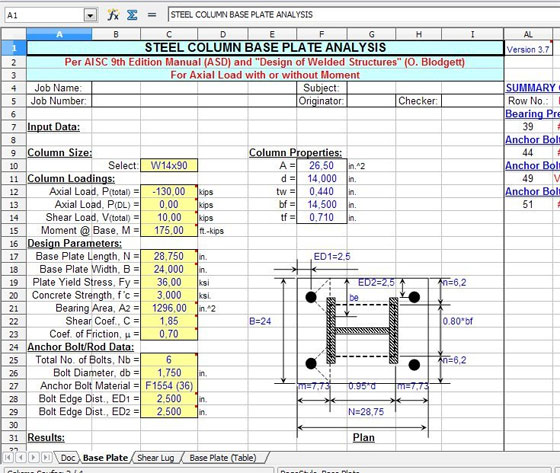BASEPLT9 3.7 is a useful construction program for structural analysis

Alex Tomanovich has developed BASEPLT9. It is an excel based construction program that can be used for structural analysis specially for analyzing steel column base plates. Particularly, wide flange column base plates are dependent on axial loads (compression or tension), with or without major-axis column bending together major-axis shear.
If required base plate bearing pressure is modified as bolt tension. With the existence of shear, bolt shear and interaction of bolt tension and shear, if necessary, are measured. In the end, estimation is made for the necessary base plate thickness. There exist an individual worksheet for base plate shear lug design, if shear load is high and not manageable efficiently with bolts.
Program Assumptions and Limitations:
1. This program abides by the methods and guidelines of the AISC 9th Edition Allowable Stress (ASD) Manual (2nd Revision, 1995) toward wide flange column base plates based on axial compressive load only.
2. This program applies a "cubic equation" procedure for providing solution for column base plates based on axial compression or tension load through major axis column bending.
3. There is option to draw out some of the total shear via friction amid column base and grout based on column dead load and coefficient of friction, thus it minimizes the amount of shear obtained by anchor bolts.
4. This program applies the database of member dimensions and section properties from the "AISC Shapes Database", Version 3.0 (2001) and the AISC 9th Edition (ASD) Manual (1989).
Link for download Steel column base plate analysis Spreadsheet
5. This program accepts that the base plate is rigid enough to assume linear distribution of load to the base plate and/or anchor bolts. (Note: acceptable base plate rigidity is reasonably satisfied if the distance from the face of the column to the edge of the base plate is <= 4*tp. See "General Anchorage to Concrete", TVA Civil Design Standard DS-C1.7.1 (Rev. 1984), page 25.)
6. To deal with anchor bolt tension and base plate bearing, this program measures the bending moment in the base plate at two locations. One, at the column flange in compression by applying the bearing pressure distribution, and the other at the column flange in tension applying the tension in one bolt allocated over an assumed width effective plate width based on edge distances and bolt spacing. At both locations, the moment and resulting base plate thickness are measured through a "cantilever" length corresponding the estimated "m" distance from the AISC code. Then, the larger of the two estimated thickness values is assigned for the essential base plate thickness.

|